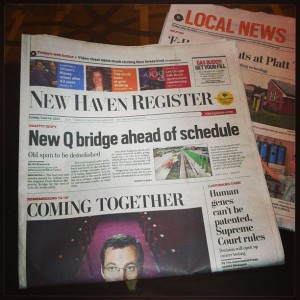
Katharine Graham believed that Joseph Allbritton hoped to take advantage of the 1975-’76 strike against The Washington Post. Photo by Reading/Simpson, noncommercial use permitted.
Robert Allbritton last week sold Politico to the German media company Axel Springer for $1 billion. Ben Smith, who was part of the launch back in 2007, wrote about the sale earlier this week in The New York Times. I wrote about the two-generation rivalry between the Allbrittons and the Graham family, who controlled The Washington Post until 2013, in “The Return of the Moguls.” Below is an excerpt.
Katharine Graham’s other crucial move was to endure a strike in 1975 in order to get the Post’s printing costs under control. So arcane were the work rules that when an advertiser submitted a finished ad (known in the post-hot-lead, pre-computer age as “camera-ready”), a union compositor still put together an equivalent ad, even though it would be discarded as soon as he was finished with it. In deciding to put a stop to such practices, Graham was fortunate in the viciousness of her opposition. At one demonstration, a leader of the union, Charlie Davis, carried a sign that read “Phil Shot the Wrong Graham,” a reference to Phil Graham’s suicide. On the night that the pressmen went on strike, some of them beat the night foreman and started a fire in an attempt to sabotage the machinery. Because of those actions they earned the enmity of the Newspaper Guild, which represented the reporters. With the paper’s journalists crossing the picket line, the Post was able to resume publishing after just one missed day, enabling them to break the strike. The benefits of being able to modernize production were immediate, as income grew from about $13 million a year to $24.5 million in 1976 and to $35.5 million in 1977.
Not all observers were sympathetic to the Grahams. Ben Bagdikian, a former Post national editor who spent much of his long, distinguished career after leaving the paper as an academic and a harsh critic of corporate journalism, wrote an article in the Washington Monthly attributing the strike to Katharine Graham’s earlier decision to go public. “The idiosyncratic publishers, whose integrity led them to ignore narrow economic arguments in favor of quality, and who as a result created America’s great newspapers, are disappearing,” Bagdikian wrote. “They were being replaced by profit-maximizing conglomerate owners. It is a forecast of trouble for independent journalism in the country’s most important news companies.” Graham recorded her response in a note to Ben Bradlee: “I am really embarrassed to think this ignorant biased fool was ever national editor. Surely the worst asps in this world are the ones one has clasped to the bosom.”
The Post’s rivalry with The Washington Star played a small role in the strike as well, a tidbit of interest mainly because of who owned the Star at that time: Joe Allbritton, a Texan who had acquired the paper from the Kauffmann family in 1974. Katharine Graham wrote that Allbritton declined to help the Post during the strike because, in her view, the only way the Star could stay in business was for the Post to fail. Allbritton sold the Star to Time Inc. in 1978, which closed it in 1981 even though Katharine Graham, Donald Graham and Warren Buffett had made overtures to set up a joint operating agreement under which both papers would be published.
The Allbritton family’s ambitions remained entangled with the Post for many decades to come. Years later, two Post journalists, John Harris and Jim VandeHei, were rebuffed when they proposed setting up a separate political website under the paper’s umbrella. They took their idea to Joe Allbritton’s son, Robert, who helped them launch Politico in 2007. With its hyperkinetic insider’s approach to covering politics, the site quickly established itself as a serious rival to the Post on one of its signature beats, although Politico was often criticized for emphasizing the superficial horse race aspects of politics.
Robert Allbritton also backed a site cheekily named TBD.com (for “to be determined”), edited by the former washingtonpost.com editor Jim Brady and the future Post media blogger Erik Wemple, which covered local news in the Washington area in conjunction with a television station the Allbrittons had owned since acquiring the Star. Fortunately for the Grahams, Allbritton lost patience with it within months of its 2010 launch, and in 2012 the site was shut down. Another Allbritton connection: About a year after Jeff Bezos bought the Post, he hired Frederick Ryan, a former Reagan administration official, to replace Katharine Weymouth as publisher. At the time that the move was made, Ryan was president and chief operating officer of Allbritton Communications and had served as Politico’s first chief executive.
The Post and Politico make for a fascinating contrast. Both companies are ensconced in brand-new headquarters on either side of the Potomac; Politico occupies part of an office tower in the Rosslyn section of Arlington, Virginia. The missions of the two organizations are very different. The Post is a general-interest newspaper with a substantial print presence. Politico is aimed at people in the professional political community, and though it publishes a small print product (daily when Congress is in session; weekly otherwise), it’s mainly digital. Yet if the ancient rivalry between the Post and The New York Times is mostly journalistic and symbolic, the Post’s rivalry with the Allbritton family has involved serious competition over whose news organization will prove to be more financially successful in the long run.
Correction: I have learned that the elder Albritton’s legal name was Joe, not Joseph. Unfortunately, it remains wrong in the book.




